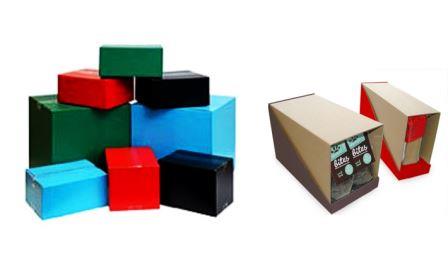Distribution networks and brands insist on paper secondary packaging

An ever growing trend in the retail sector worldwide is the use of secondary paper packaging. Brands that belong to the food and beverages industry, prefer this kind of secondary packaging, because it combines functionality and the flexibility to adapt to changing tastes and consumption patterns of buyers and their environmental friendliness. Still, the reason that paper secondary packaging is very popular nowadays is because of the boom of e-commerce. Indicatively, it is estimated that the market for corrugated paper packaging will grow annually by 4% over the period 2014-2020.
North America is currently the largest market in the US to lead the demand for such packages. Typically, according to a report of the American Alliance Paper Secondary Packaging (CPA, 2010) about 90% of products shipped to the USA is arranged in such packaging. Similarly, in the Asia-Pacific region, China represents the largest market and along with India, Japan and Indonesia are the major manufacturing centers of corrugated paper packaging, which is mainly due to the growth of industrial production in the emerging economies. Indeed, the rise in demand for such packages in China is mainly due to the development of the food and health sectors, which constitute the largest end users of these packages in the region. Similarly in Europe, France, Italy, Germany, the United Kingdom, Spain and Poland are the largest markets for this type of packaging, while the rest of the world dominate Turkey and Brazil.
But what are the specific features of secondary paper packaging to seem be preferred both by retailers and brands from the food and beverage industry worldwide?
First of all, they are durable and lightweight, which makes them ideal for the protection and preservation of the products during transportation.
Secondly, their surface can be decorated with graphics of high quality projects, so these packages can be used as an effective marketing tool for brands, in order to attract consumers.
 They can also incorporate innovative features that enhance the interaction with the prospective buyer informing or entertaining him, or confirming the authenticity of the products containing, eg QR codes are read by mobile devices.
They can also incorporate innovative features that enhance the interaction with the prospective buyer informing or entertaining him, or confirming the authenticity of the products containing, eg QR codes are read by mobile devices.
They have a small ecological footprint, as manufactured from renewable raw materials and can be recycled and reused contributing to waste reduction.
And last but not least, they can be produced in different sizes and shapes (personalization), depending on the primary packaging, without generating any additional costs or delays during the production process.
Thanks to those features, food and beverage industries and retail sales (online and off-line) always resort to such packages as they guarantee absolute product maintenance during transportation and storage and their easy and quick placement on the shelves in order to differentiate from the rest.
An illustrative example is paper secondary package consisting externally of 100% recycled cardboard and comprising a lining material made from paper that supports the entire structure, making it more resistant to vibration. It can be decorated with high quality graphics (holograms, metallic inks for glossy look) gaining the attention of the consumer, and can incorporate features such as handles or tear strips for easy opening and closing of the pack. This innovative package was developed by an American paper packaging manufacturer in order to provide an ecological and efficient solution to the brands owners and retailers, helping them deliver a better consumer experience to their customers and thus increase their sales.
comprising a lining material made from paper that supports the entire structure, making it more resistant to vibration. It can be decorated with high quality graphics (holograms, metallic inks for glossy look) gaining the attention of the consumer, and can incorporate features such as handles or tear strips for easy opening and closing of the pack. This innovative package was developed by an American paper packaging manufacturer in order to provide an ecological and efficient solution to the brands owners and retailers, helping them deliver a better consumer experience to their customers and thus increase their sales.
 Another interesting solution is the secondary durable and easily transportable packaging made of corrugated cardboard, which through notches in the corners, allows consumers to see the glass bottles it contains. It opens easily, it is environmentally friendly and can incorporate graphic designs on its surface. Worth mentioning is the fact that it can facilitate 40% more pallets, thereby reducing transport costs and that it requires 15% less material to be produced than the conventional secondary paper packaging. Moreover, the bottles are arranged in a way that they cannot rub each other during transport. This innovative packaging was used by an American brewing company to transfer four different brands of beer in bottles weighing a total of 4 pounds, as well as to promote them to clubs and cellars.
Another interesting solution is the secondary durable and easily transportable packaging made of corrugated cardboard, which through notches in the corners, allows consumers to see the glass bottles it contains. It opens easily, it is environmentally friendly and can incorporate graphic designs on its surface. Worth mentioning is the fact that it can facilitate 40% more pallets, thereby reducing transport costs and that it requires 15% less material to be produced than the conventional secondary paper packaging. Moreover, the bottles are arranged in a way that they cannot rub each other during transport. This innovative packaging was used by an American brewing company to transfer four different brands of beer in bottles weighing a total of 4 pounds, as well as to promote them to clubs and cellars.
Similarly, cartons of corrugated paper made from grape skins, which is fully biodegradable and recyclable, includes labels that are glued using cane and can incorporate graphic designs, used by a French champagne production company to offer its customers an ecological solution for its products.
 Another typical case constitutes a carton produced from cellulose which incorporates a transparent, flexible resilient strip that keeps products safe in the center of the package, protecting them from damage during transport. This strip can be adapted to various shapes of packaging, reducing production and storage costs. Another version of that package is the development of two rectangular frames incorporating resistant transparent stripes, referring to a kind of window. One is positioned at the base of the pack and the other above the product, providing protection also in case of fall. Both versions of the package as a whole is recyclable and can be reused even for returning products, helping to reduce waste throughout the supply chain. They were both developed by an American packaging company in order to meet the demand from logistics service providers and e-retailers.
Another typical case constitutes a carton produced from cellulose which incorporates a transparent, flexible resilient strip that keeps products safe in the center of the package, protecting them from damage during transport. This strip can be adapted to various shapes of packaging, reducing production and storage costs. Another version of that package is the development of two rectangular frames incorporating resistant transparent stripes, referring to a kind of window. One is positioned at the base of the pack and the other above the product, providing protection also in case of fall. Both versions of the package as a whole is recyclable and can be reused even for returning products, helping to reduce waste throughout the supply chain. They were both developed by an American packaging company in order to meet the demand from logistics service providers and e-retailers.
Therefore, the secondary cartons are a convenient and efficient solution for the food and beverage industry as well as the retail industry including electronic retail stores. This is because it reduces the cost of production, transportation and storage. It is environmentally friendly, it is easily adaptable to the content, it ensures good maintenance of the products and facilitates the communication of brands with their clients.
References : Waqas Qureshi (2015), Tony Corbin (2015), Jim Butschli (2012) www.packagingeurope.com, www.packworld.com, www.paperworksindustries.com, www.packagingnews.co.uk, www.pmpnews.com

